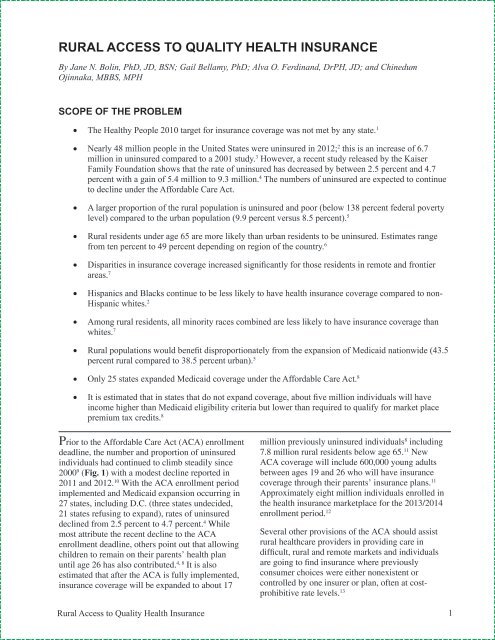1Cb1NJ5
1Cb1NJ5
1Cb1NJ5
Create successful ePaper yourself
Turn your PDF publications into a flip-book with our unique Google optimized e-Paper software.
RURAL ACCESS TO QUALITY HEALTH INSURANCE<br />
By Jane N. Bolin, PhD, JD, BSN; Gail Bellamy, PhD; Alva O. Ferdinand, DrPH, JD; and Chinedum<br />
Ojinnaka, MBBS, MPH<br />
SCOPE OF THE PROBLEM<br />
• The Healthy People 2010 target for insurance coverage was not met by any state. 1<br />
• Nearly 48 million people in the United States were uninsured in 2012; 2 this is an increase of 6.7<br />
million in uninsured compared to a 2001 study. 3 However, a recent study released by the Kaiser<br />
Family Foundation shows that the rate of uninsured has decreased by between 2.5 percent and 4.7<br />
percent with a gain of 5.4 million to 9.3 million. 4 The numbers of uninsured are expected to continue<br />
to decline under the Affordable Care Act.<br />
• A larger proportion of the rural population is uninsured and poor (below 138 percent federal poverty<br />
level) compared to the urban population (9.9 percent versus 8.5 percent). 5<br />
• Rural residents under age 65 are more likely than urban residents to be uninsured. Estimates range<br />
from ten percent to 49 percent depending on region of the country. 6<br />
• Disparities in insurance coverage increased significantly for those residents in remote and frontier<br />
areas. 7<br />
• Hispanics and Blacks continue to be less likely to have health insurance coverage compared to non-<br />
Hispanic whites. 2<br />
• Among rural residents, all minority races combined are less likely to have insurance coverage than<br />
whites. 7<br />
• Rural populations would benefit disproportionately from the expansion of Medicaid nationwide (43.5<br />
percent rural compared to 38.5 percent urban). 5<br />
• Only 25 states expanded Medicaid coverage under the Affordable Care Act. 8<br />
• It is estimated that in states that do not expand coverage, about five million individuals will have<br />
income higher than Medicaid eligibility criteria but lower than required to qualify for market place<br />
premium tax credits. 8<br />
1<br />
Prior to the Affordable Care Act (ACA) enrollment million previously uninsured individuals 8 including<br />
deadline, the number and proportion of uninsured 7.8 million rural residents below age 65. 11 New<br />
individuals had continued to climb steadily since ACA coverage will include 600,000 young adults<br />
2000 9 (Fig. 1) with a modest decline reported in between ages 19 and 26 who will have insurance<br />
2011 and 2012. 10 With the ACA enrollment period coverage through their parents’ insurance plans. 11<br />
implemented and Medicaid expansion occurring in Approximately eight million individuals enrolled in<br />
27 states, including D.C. (three states undecided, the health insurance marketplace for the 2013/2014<br />
21 states refusing to expand), rates of uninsured enrollment period. 12<br />
declined from 2.5 percent to 4.7 percent. 4 While<br />
most attribute the recent decline to the ACA Several other provisions of the ACA should assist<br />
enrollment deadline, others point out that allowing rural healthcare providers in providing care in<br />
children to remain on their parents’ health plan difficult, rural and remote markets and individuals<br />
until age 26 has also contributed. 4, 8 It is also are going to find insurance where previously<br />
estimated that after the ACA is fully implemented, consumer choices were either nonexistent or<br />
insurance coverage will be expanded to about 17 controlled by one insurer or plan, often at costprohibitive<br />
Rural Access to Quality Health Insurance<br />
13<br />
rate levels.


